Wind River Experimental Forest NEON (WREF) Soil Descriptions
Distributed Soils Reports
Pedon Descriptions
Pit‐level observations and field measurements reported using the standard NRCS format. They contain volume estimates for coarse fragments > 20 mm where applicable.
Site Level Plot Summary
A narrative summary that places the sampled soil pedons in the broader context of soils and geomorphology for the entire NEON site.
Megapit Images
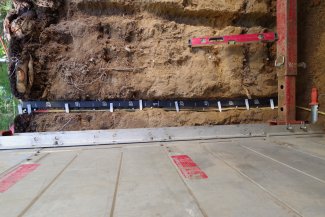
D16 WREF megapit soil profile 0-193 cm
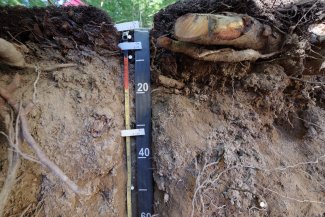
D16 WREF megapit soil profile 0-58 cm
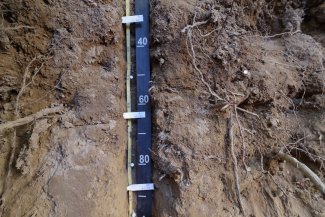
D16 WREF megapit soil profile 24-95 cm
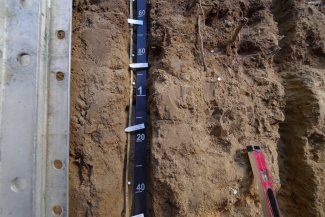
D16 WREF megapit soil profile 50-147 cm
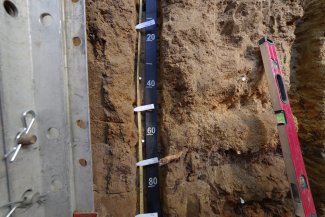
D16 WREF megapit soil profile 103-188 cm
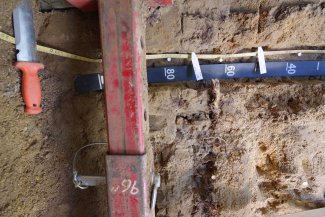
D16 WREF megapit soil profile 129-200 cm
Megapit Pedon Description
| Print Date | Feb 4 2019 |
|---|---|
| Description Date | Sep 26 2017 |
| Describer | Daniel Ufnar |
| Site ID | 2017WA059001_MP |
| Pedon ID | S2017WA059001_MP |
| Lab Source ID | KSSL |
| Lab Pedon # | 18N0001 |
| Soil Name as Described/Sampled | Stabler |
| Classification | Medial, amorphic, mesic Typic Hapludands |
| Pedon Type | taxadjunct to the series |
| Pedon Purpose | research site |
| Taxon Kind | taxadjunct |
| Geomorphic Setting | on tread of None Assigned |
| Upslope Shape | linear |
| Cross Slope Shape | linear |
| Particle Size Control Section | 9 to 109 cm. |
| Description origin | NASIS |
| State | Washington |
| County | Skamania |
| MLRA | 3 -- Olympic and Cascade Mountains |
| Soil Survey Area | WA760 -- Gifford Pinchot National Forest Area, Washington |
| Std Latitude | 45.8164290 |
| Std Longitude | -121.9584660 |
| Datum | WGS84 |
| Primary Earth Cover | Tree cover |
| Secondary Earth Cover | Conifers |
| Existing Vegetation | bride's bonnet, Cascade barberry, Douglas-fir, grand fir, Pacific trillium, red huckleberry, salal, sweet after death, vine maple, western hemlock |
| Parent Material | volcanic ash mixed with alluvium over debris flow deposits |
| Description database | KSSL |
| Diagnostic Features | ochric epipedon to cm. cambic horizon 9 to 80 cm. andic soil properties 9 to 136 cm. aquic conditions 162 to 200 cm. redox concentrations 162 to 200 cm. |
| Slope (%) | 3.0 |
| Elevation (meters) | 381.0 |
| Aspect (deg) | 220 |
| Drainage Class | well |
| Horizon Details |
Oi--0 to 3 centimeters (0.0 to 1.2 inches); slightly decomposed plant material; many medium roots and many fine roots and many coarse roots; abrupt smooth boundary. Lab sample # 18N00001 Oa--3 to 9 centimeters (1.2 to 3.5 inches); highly decomposed plant material; many very coarse roots and many medium roots and common coarse roots; abrupt smooth boundary. Lab sample # 18N00002. 1-2 mm lens of volcanic ash, assumed to be Mount St Helens 1980 eruption. Ac--9 to 50 centimeters (3.5 to 19.7 inches); dark brown (7.5YR 3/3) broken face medial loam, pale brown (10YR 6/3) broken face, dry; 45 percent sand; 13 percent clay; moderate fine granular structure; soft, very friable, nonsticky, slightly plastic; weakly smeary; common very fine roots and few very coarse roots and common fine roots and common coarse roots; many very fine irregular and common medium irregular pores; 2 percent nonflat subangular moderately cemented 5 to 10-millimeter iron-manganese concretions and 3 percent nonflat subrounded moderately cemented 2 to 5-millimeter iron-manganese concretions; gradual wavy boundary. Lab sample # 18N00003 Bw--50 to 80 centimeters (19.7 to 31.5 inches); dark brown (7.5YR 3/4) broken face medial loam, light yellowish brown (10YR 6/4) broken face, dry; 45 percent sand; 15 percent clay; weak fine subangular blocky structure; soft, very friable, nonsticky, slightly plastic; weakly smeary; common medium roots and common fine roots and common coarse roots; common very fine tubular and few medium irregular and few medium tubular pores; gradual wavy boundary. Lab sample # 18N00004 BC--80 to 94 centimeters (31.5 to 37.0 inches); dark yellowish brown (10YR 4/4) broken face medial sandy loam, light yellowish brown (10YR 6/4) broken face, dry; 60 percent sand; 14 percent clay; weak medium subangular blocky structure; slightly hard, friable, nonsticky, slightly plastic; weakly smeary; common medium roots and few coarse roots; few very fine tubular and few fine irregular and few fine tubular pores; gradual smooth boundary. Lab sample # 18N00005 2C1--94 to 136 centimeters (37.0 to 53.5 inches); dark yellowish brown (10YR 4/4) broken face medial sandy loam, light yellowish brown (10YR 6/4) broken face, dry; 75 percent sand; 10 percent clay; massive; hard, firm, nonsticky, nonplastic; weakly smeary; few very fine roots and few medium roots; few very fine tubular pores; abrupt irregular boundary. Lab sample # 18N00006 2C2--136 to 162 centimeters (53.5 to 63.8 inches); 45 percent strong brown (7.5YR 5/6) broken face and 35 percent strong brown (7.5YR 4/6) broken face and 20 percent pinkish gray (7.5YR 6/2) broken face ashy sandy loam, 45 percent pink (7.5YR 7/4) broken face and 35 percent strong brown (7.5YR 5/8) broken face and 20 percent pinkish gray (7.5YR 7/2) broken face, dry; 75 percent sand; 7 percent clay; massive; slightly hard, friable, nonsticky, nonplastic; few very fine roots; few very fine tubular and common fine irregular pores; abrupt smooth boundary. Lab sample # 18N00007 3Ab--162 to 178 centimeters (63.8 to 70.1 inches); very dark grayish brown (10YR 3/2) broken face medial sandy loam, grayish brown (10YR 5/2) broken face, dry; 70 percent sand; 13 percent clay; massive; hard, firm, nonsticky, nonplastic; weakly smeary; few very fine roots and common fine roots; few fine irregular and common fine tubular pores; 2 percent fine prominent 7.5YR 5/6), moist, masses of oxidized iron lining pores; gradual irregular boundary. Lab sample # 18N00008 3Cg--178 to 200 centimeters (70.1 to 78.7 inches); dark grayish brown (2.5Y 4/2) broken face medial sandy loam, light yellowish brown (2.5Y 6/3) broken face, dry; 75 percent sand; 10 percent clay; massive; hard, firm, nonsticky, nonplastic; weakly smeary; few fine irregular and common fine tubular pores; 5 percent fine prominent 7.5YR 5/6), moist, masses of oxidized iron lining pores. Lab sample # 18N00009. |
Credits: This megapit soil pedon description was generously created by USDA Natural Resource Conservation Service staff, with particular thanks to Larry West, Jon Hempel, and numerous field staff.